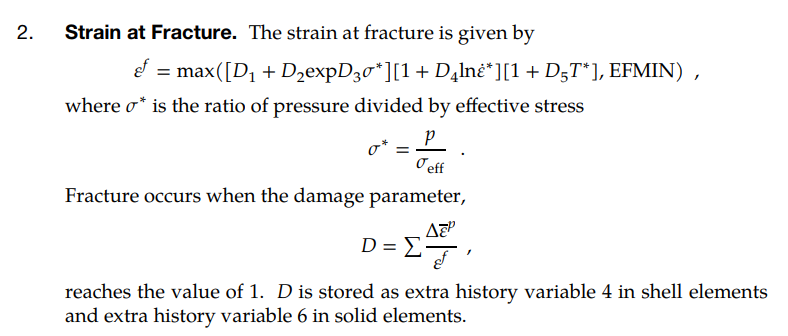TAGGED: cutting-2d-model, lsdyna, orthogonal-cutting
-
-
April 15, 2025 at 1:35 pm
Jack.Vincent
SubscriberHi,
I'm trying to recreate this paper using workbench LS-DYNA: https://www.researchgate.net/profile/Tarek-Mabrouki/publication/226320372_Dry_cutting_study_of_an_aluminium_alloy_A2024-T351_A_numerical_and_experimental_approach/links/0912f511df7e779f32000000/Dry-cutting-study-of-an-aluminium-alloy-A2024-T351-A-numerical-and-experimental-approach.pdf
I have looked at this ANSYS tutorial: https://innovationspace.ansys.com/courses/wp-content/uploads/sites/5/2024/03/4_Performing-Metal-Cutting-Analysis-using-LS-Dyna.pdf
The issue I am finding is the value in the tutorial given for EFFEPS is -1.5 which is quite high when compared to the D1 parameter given in the paper of 0.13. This is leading to brittle failure of the billet rather than a nicely formed chip as shown in Abaqus model they used in the paper. There is lots of literature around using SPH/SPG methods which I have been able to replicate but I would like to replicate this using normal FEM elements as in the paper. Any advice would be greatly appreactied.
-
April 15, 2025 at 7:29 pm
igandiko
Ansys Employee*MAT_ADD_EROSION is typically used with material models that do not allow failure/element erosion. This card does not take damage into account, element erosion is simply based on the defined failure criteria. The material parameter values used in Ansys tutorial is for representative purposes only.
To get similar results as the paper, perhaps you can incorporate damage either using one of the material model that supports damage (https://lsdyna.ansys.com/dynamat/ -> set feature to damage to see a list of material models) or use *MAT_ADD_DAMAGE_<>. Have you considered MAT15 which is similar to the one in the paper?
-
April 16, 2025 at 9:22 am
Jack.Vincent
SubscriberHi Igandiko,
Yes, I have tried Mat15 but this still leads to brittle failure and no formation of swarf/chip when using FEM elements though seems to be okay with SPG.
-
April 16, 2025 at 12:15 pm
Ram Gopisetti
Ansys EmployeeHi Jack,
Could you please elaborate on how brittle failure is quantified in your model? Additionally, would it be possible for you to share some images of your results?
It's important to note that there is no direct correlation between the damage values provided by MAT_015 (which is calibrated using a set of stress-strain curves incorporating strain rate dependency) and the scalar damage value defined in EFFEPS under MAT_ADD_EROSION, where strain rate effects are not considered.
For reference on Lagrangian element-based cutting simulations involving ductile fracture, please see the following article:
https://www.dynamore.eu/en/downloads/papers/dynamore/de/download/papers/forum08/dokumente/C-III-01.pdf.
This paper outlines the model setup using MAT_098 (a simplified version of the Johnson-Holmquist model) and applies PSFAIL to define failure and achieve ductile chip formation.However, the Lagrangian approach has limitations in accurately capturing failure mechanisms. In this context, particle-based methods such as SPG and SPH offer significant advantages. A more robust and validated example of cutting simulation using SPG can be found here:
https://www.lstc-cmmg.org/cutting.Cheers, Ram
-
April 16, 2025 at 4:12 pm
Jack.Vincent
SubscriberHi Ram,
By brittle failure, I see 'chunks' of mesh fly off rather than a continous chip being formed. Though I can now also get it to not erode at all and just 'push' the mesh until it falls over.
I'll try MAT_098 but again in that paper it refers to a much higher PSFAIL value that I would be using.
Yes, I agree that the SPG route is good and have used it to replicate the paper well. I am just trying to replicate the paper using FEM elements currently which is proving harder than I thought.
Thanks, Jack
-
- You must be logged in to reply to this topic.



-
2858
-
970
-
851
-
599
-
591

© 2025 Copyright ANSYS, Inc. All rights reserved.








